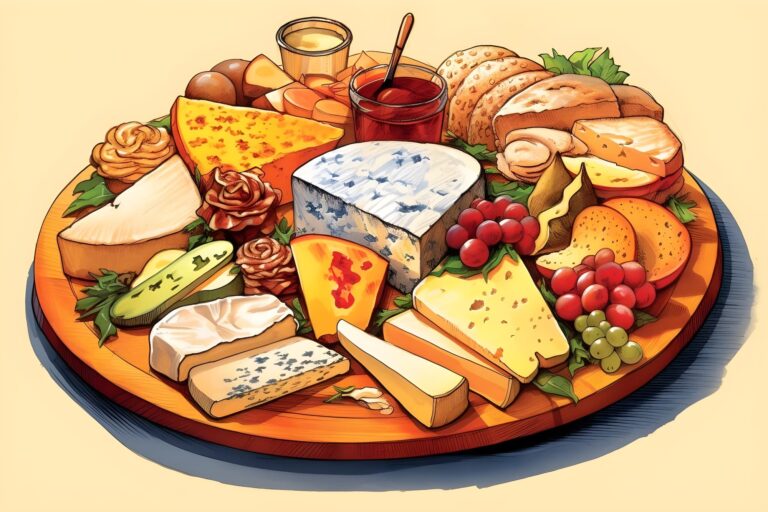Living in Mauritius — A Complete Review
Mauritius is a place of many contrasts. There’s accommodation that’s deathly expensive and street food that’s extremely cheap. There are peaceful coastal areas and hectic urban sprawl. There are three languages spoken but you almost definitely don’t speak the most widely spoken one.
It’s complicated and hard to sum up what living in Mauritius is like. So here’s our total — and long — guide to living in Mauritius.
We’ve spent a few years living in different destinations, gradually extending the amount of time we stay in a country or area. We decided to stay in Mauritius for three months to give it a good go.
Before we came here, we found very little info on Mauritius other than what tourists had written. We wanted to know:
- Where should we live in Mauritius?
- How much does it cost to live in Mauritius?
- What’s Mauritian food like?
- What’s the Mauritian lifestyle, language, and culture situation?
- Is there much natural beauty in Mauritius?
- How do we get around Mauritius?
- How do we get a sim card in Mauritius?
This is our quick guide to all that.

Living in Mauritius — Brief overview
Generally speaking, Mauritius is a good candidate for a digital nomad lifestyle.
You get the basics of: fast, good internet access, comfortable and affordable accomodation, and cheap and decent food.
But there are definitely a few caveats. There are definitely hard parts about living in Mauritius. A few of these are: language (the most widely spoken one is Mauritian Creole), traffic, weather craziness, and the availability of fresh produce (as it’s a small island).
If you can get past those caveats, Mauritius is quite an interesting place.
Though technically part of Africa, Mauritians are quick to remind you that they’re not African. Whatever you choose this to mean, they’re trying to say that Mauritius has its own unique identity stemming from its history that you wouldn’t associate with the culture of any one African country. (But then again, each African country / region has distinct customs and cultures, so I’m not sure exactly what Mauritians mean when they say that.)
Very briefly, Mauritius has a colonial history and also one of indentured servitude. Many of the people of Mauritius now are descendants either of indentured servants (obviously freed many generations ago) or of traders who settled in the area.
People speak English (the official language) and French (learned socially / through school), though the most widely spoken language is Mauritian Creole. Mauritian Creole has the strongest link with Mauritian identity.
These days, Mauritius is still carving its path forward as a small but indepenent nation — its own currency, language, and unique culture.
Where should you live in Mauritius?
If we were to come back and try living in Mauritius again, we’d live in Tamarin / Flic en Flac. Basically, the west coast.
Learn from our mistake: Don’t live in the busiest areas of either Port Louis or Beau Bassin / Rose Hill.
In other countries, we generally look for “busy” areas where there are cafes, restaurants, and so on. We did that in Mauritius too, and found a decent full home for a good price (including cleaning services) right in Beau Bassin / Rose Hill, thinking that this was the “happening” area.
While the house is nice and we love the air con and cleaning, there’s nothing particularly “fun” around here and the traffic is ridiculous.
Initially, we stayed away from Tamarin and Flic en Flac because it seemed “touristy”. It’s true — expats do live there.
But what we noticed after visiting that area is is that it’s not like it’s just an expat town. There’s a heavy amount of local culture too.
On top of that, in the coastal areas there’s nowhere near as much traffic, there are ample services, and there’s the beach. Everyone shares the beach — you can even use the beach in front of resorts (it’s public property until the high-tide line).
So that’s our short answer. Live in Tamarin or Flic en Flac!
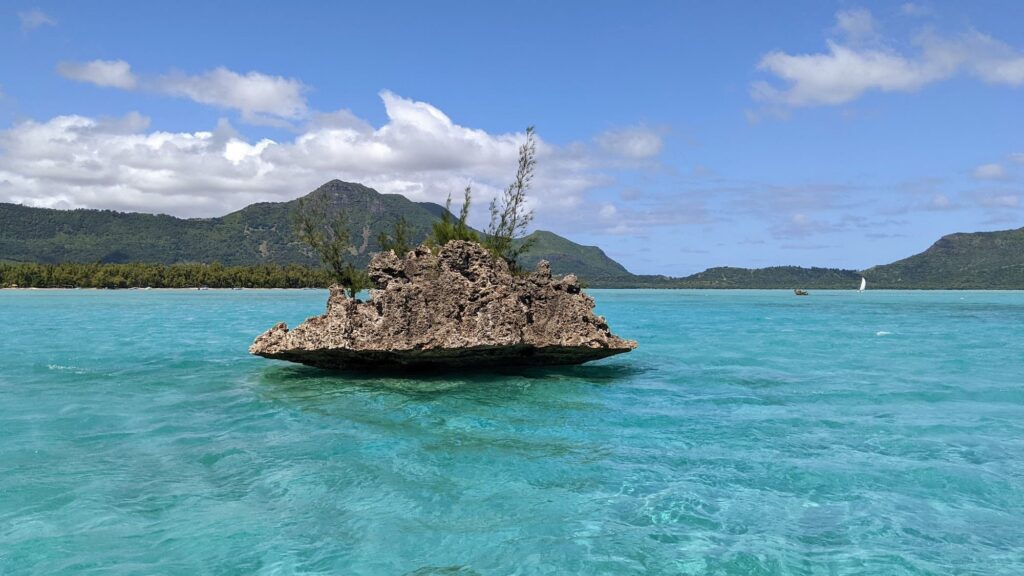
Is Mauritius Expensive? Cost of living breakdown
Something people often tell me is that Mauritius is “very expensive” — even from the perspective of foreigners.
(See below notes on the wealth poverty gap. Due to relatively low domestic salaries, from the perspective of many Mauritians, life in general is becoming more and more expensive.)
People say this based on the prices of hotels/resorts. It’s true, they’re VERY expensive. The cheapest “OK” resort we found is about US$200 a night, and they go into the thousands. Yes, thousands of US dollars a night!
Of course, those are very beautiful, and on coastline that will make you gasp at the beauty of the water, and I’m not even really a water person.
But you can definitely live a cheaper “digital nomad” style lifestyle in comfort and spend much less money than you would in, for example, Europe or the US.
Here’s what you can expect to spend living in Mauritius (all in USD)
- Rent for a “decent” apartment (1-2 bedrooms, clean, well-furnished, good area, maybe even weekly cleaning): $600-1200 a month (this is still expensive for locals, but it’s decent for travellers)
- Car rental: US$20 a day, or around $450 a month for a monthly rate
- Scooter rental: $15/day, $300/month
- Full shopping cart of groceries: hard to break $100
- Meal out: $1-2 for really nice street food (e.g. a roti and curry), $3-4 for sit-down Mauritian fare (e.g. noodles, mine bouillie) $7-8 for a nice meal from a mid-range restaurant (e.g. good burger, fries and drink, or an Indian curry and lassi), or you can spend $25+ if you go fancy sit-down.
- Sim card with gobloads of data: $10/month
In general, Mauritius is a good place to spend very little.
The one caveat is that you almost definitely need a scooter or a car. I haven’t found a part of the island where you wouldn’t need one. It’d be very boring to not have transport in Mauritius as the public transport situation is not good — unless you really are content with your local area.
A Very Brief History of Mauritius
To understand Mauritian culture, it’s important to have an understanding of its history.
Mauritius was actually uninhabited until various European nations started colonising it a few hundred years ago, bringing with them slaves and indentured servants, and later attracting traders. Previously, Arab and Portuguese explorers had found the island and marked it on maps, but not occupied it.
It was the Portuguese who gave the names Rodrigues to the smaller, much wilder Mauritian island, and Reunion to the nearby French territory. They also gave the name Mascarenes to the island now known as Mauritius.
In 1598, Dutch explorers also landed at Mauritius. They named it Mauritius in honor of Prince Maurice Van Nassau. In other languages, Mauritius is known as “Maurice” (French) or “Mauricio” (Spanish), reflecting its namesake.
The Dutch made a half-hearted attempt to colonise Mauritius but couldn’t get anything profitable going. But it was from Mauritius that Abel Tasman launched his expedition in which Europe realised that Australia existed.
The Dutch left in 1710, giving up on this pocket of paradise to the first taker.
Then the French arrived in 1715 and said “OK, let’s farm sugar cane here.”
To make their sugar cane productions profitable, as with elsewhere, the French rulers used slaves. According to some research slaves made up over 80% of the population of the island by the time French rule ended, with 160,000 slaves arriving at the island — 87% of whom were from various parts of Africa and 13% from India.
The French called Mauritius “Isle de France”, and considered it an important naval and trading port. But the British noticed its importance strategically, and so took over the island in 1810 during the Napoleonic wars.
While the British kicked out the French rulers, they didn’t really try to colonise Mauritius. Instead, they just managed the island through the French ruling class who stayed and managed the plantations. This let the British have an easy change of power.
To ease the transition, the British promised to respect a lot of what the French had instituted in the island: rules about private property, religion (Catholicism — the French imposed this on the slave population) free trade, customs, the use of the French language, and slavery.
The British did set English as the official language of government. But because they didn’t try to colonise Mauritius and just managed it through the existing French, they didn’t try to impose English as a dominant language on the island. So French stayed as the dominant language, and Mauritian Creole evolved as a simplified version of French.
The British, via the French who stayed, continued using the slaves on the plantations.
But then following a period of growing resistance to slavery, the British Empire abolished slavery in most colonies in 1833, taking effect in 1835 in Mauritius.
The British emancipated their slaves in 1839 (first they kept them on as “apprentices” for four years after 1835), but didn’t really provide any resources for them to integrate into society. Many of the new free people fell into poverty.
After slavery, the British needed a new source of free labour, and invented the concept of the “indentured servant” for this purpose. Some sources even claim that the British pioneered this dubious concept in Mauritius, later expanding it to many other places.
The British brought many Indian indentured servants from India. They came willingly, in a way, trying to escape the harsh conditions of the place in which they were, where they were variably affected by unemployment, floods, epidemics, famines, and caste-based oppression.
Under the terms of their contracts, indentured servants provided labor for a fixed contract term (5 years was common) in return for food and board, but not pay. They had some limited rights while working in Mauritius. They technically weren’t slaves, but their lives were still pretty hard. And at the end — assuming they weren’t penalised for some reason and had their contracts extended — they’d be free.
But predictably, many records showed that even though “indentured labour” has a different name, the British Empire recruited and treated them similarly to how they treated slaves.
“Workers were often recruited with brutal force; on their way to Mauritius, many died of diseases; on the island they were subjected to travel restrictions; and once they made it to the estates, workers were treated badly, including harsh corporal punishment and even imprisonment on estates.”
Stanford University, Mauritian Archaeology
The British Empire only ended indentured labour in 1924. By then, the vast majority of people living in Mauritius were of mixed Indian descent or of African descent, descendants of the emancipated slaves or other traders. At the time, India included the country now known as Pakistan, so the newer inhabitants of Mauritius were (and remain) mostly of Hindu and Muslim faiths, alongside the Catholic community from French times.
Alongside indentured labourers, traders came to Mauritius. Some of these were from Africa, some from India, and also some from the South of China. The latter formed what is now known as the “Sino-Mauritian” aspect of Mauritian culture, present today in a few unique ways.
Mauritius gradually gained independence over a very long period. For a while, only the elite could vote and participate in government, but from 1948 franchise was extended to anyone who could pass a literacy test.
Eventually, Mauritius adopted a new constitution in 1968, and became a republic only recently, in March 1992.
Mauritian Lifestyle and Culture
With that historical background, now we can talk about Mauritian culture.
Mauritian culture is its own thing. It doesn’t remind me of African, Indian, or French cultures other than in occasional hints which may as well be coincidences.
Generally speaking, Mauritian culture is a blend of
- Relaxed island culture that you might find in any tropical island
- Indian historical elements (both Muslim and Hindu)
- French things (language, some foods) and the Catholicism they brought
- A small but interesting minority of Sino-Mauritian culture
- And a lot of uniquely Mauritian stuff.
Culture in Mauritius is heavily influenced by religion. There are very distinct presences of Christian (Catholic), Hindu, and Muslim religions in Mauritius.
Even though there are official percentages of people of each faith, what’s more interesting to me is that the culture of each religion is strong and distinctly present in some pockets of the island. You can go to some villages and see lots of mosques, or see Hindu temples in other regions, and churches all over.
The Constitution of Mauritius explicitly recognises four cultural groups: Hindu, Muslim, Sino-Mauritian, and the “General Population” (which is mostly Catholic).
By far, the dominant religion in Mauritius is Hindu (about 50% of Mauritians). But compounding this is that most of the people in government are of Hindu background, one of the sometimes-mentioned elements of friction in Mauritian society. For example, all Prime Ministers of Mauritius have been Hindu, and the majority of Members of Parliament are Hindu.
Secondly, culture. The Hindu and Muslim portions of the population are all of general Indian background, but they do maintain distinct superficial cultural elements.
For example, the Hindus don’t eat beef, and the Muslims do (with Briyani being a popular local Muslim food), and the Muslims don’t eat pork (though actually I don’t see much of it in Hindu food either).
The Hindus and Muslims each observe different holidays, which are public holidays for the general population. So everyone gets to benefit from that! Only the Muslims observe the month of Ramadan, but then everyone gets Eid as a public holiday.
You can even see different dress elements, particularly Muslim dress in some of the towns. And also different facial hair.
There are a few random bits of French culture locally, too. The most common form of bread is the baguette. Imported French foods (ham, cheese) are easy to get. And there are a few remnants of old French laws, like beaches being public access, even if they’re in front of a resort.
Some Mauritians identify as French Mauritians or “European”. They speak French at home and send their children to French-speaking schools. They may understand Mauritian Creole and sometimes even speak it totally naturally, but prefer to speak French.
But the culture in Mauritius is not French. It’s also not African. For example, one thing I thought I might see in Mauritius would be people greeting each other on the street with a “bonjour!”, something which I enjoy both in France as well as in East Africa. It’s a superficial and small example, but one with daily impact on me that I noticed was absent (unless I initiated).
With all this mention of religion in Mauritius, one thing I noticed from talking to people is that Mauritius definitely skews conservative. LGBT identities aren’t well-regarded in Mauritius, something supported in public opinion polls.
The final thing worth talking about in Mauritian Culture is the impact of the settling of Chinese traders.
The Chinese in Mauritius — Sino-Mauritian Culture
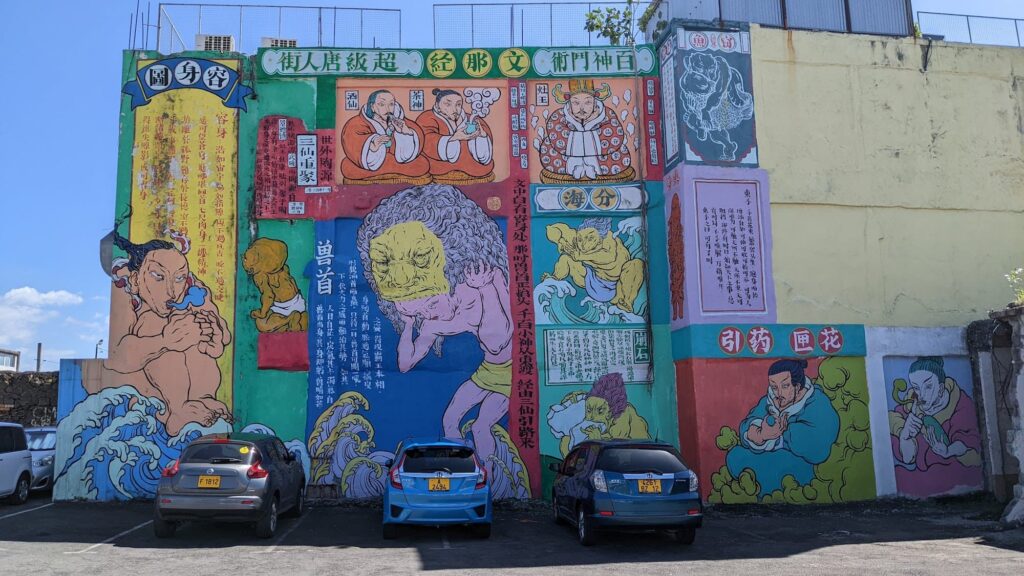
One thing I find uniquely interesting in Mauritius is the presence of the Sino-Mauritian population.
Chinese settlers came as traders over the course of the last couple of centuries. Gradually, they built a Chinatown. They even set up schools and maintained some distinct elements of Chinese culture, including providing means for young Chinese people to learn a Chinese language (usually Mandarin, though Chinese settlers did come from various other regions).
These days, there are many ethnically Chinese people living in Mauritius. Inter-cultural relationships and children exist, but they’re rare.
I have met a few Chinese Mauritians in my time in Mauritius, but haven’t spoken Chinese to any of them. I actually just didn’t want to embarrass anyone in case they didn’t speak Chinese (I don’t even know if they’d have been embarrassed, I never got to know them well enough to get past that barrier). But I’d really have loved to speak Chinese in Mauritius! It just didn’t happen.
There are some unusual aspects of the presence of Sino-Mauritians in Mauritius.
Even though the Sino-Mauritian population is Mauritian in identity, many people view them as different. It’s easy to understand this — after all, they’re specifically called out as “Sino-Mauritians” in the constitution.
One way in which the Sino-Mauritian population is perceived as different is that they are sometimes treated better than others in some establishments (considered probably to have more money, being of trader families).
And another (slightly odd) way is that sometimes strangers on the street say “ni hao” to those they assume are Sino-Mauritian — which is anyone who looks Asian.
To an outsider, it’s quite odd to see people say “ni hao” to Asian-looking people and not to anyone else. Firstly, it’s odd because of the assumption that anyone of Asian heritage speaks Mandarin. Secondly, it’s odd to assume people want to be addressed that way.
Jo did a poll on her TikTok account and results from the locals was that at best, they tolerated it; at worst, they found it annoying but also tiresome to stop. Many pointed out that it doesn’t stem from a bad place, and that they were just trying to be friendly.
But despite that, it still is a statement to the person that “you’re different from me”. It makes some Sino-Mauritians that we spoke to feel uncomfortable.
Probably the only people who’d welcome being greeted with ni hao would be the Chinese migrants coming to work for major Chinese state-owned enterprises here doing construction projects.
Another effect that Chinese migrants have had on Mauritius is the food.
There are some typical foods that many Mauritians enjoy every day that are influenced by Chinese cuisine — boiled and fried noodles, called mine bouillie and mines frites here. The word “mine” (pronounced in French or Creole like “meen”) has its roots in 麵/面 (Mandarin: mìan), the same word in the American Chinese dish “chow mein”.
These foods are very popular in Mauritius and are often recommended as things you should try. I think it’s worth it as a cultural experience, though I didn’t find them that tasty (see the section on food below).
Mauritian Society and the Wealth / Poverty Gap
From the point of view of many Mauritians, Mauritius is becoming more and more expensive.
Groceries and food in Mauritius are anywhere from “very cheap” to “normal” priced. The only things that are expensive were unusual imported goods (which is to be expected).
For example:
- A baguette costs somewhere between 10 and 20 rupees (depending on the type), translating to 25-50 US cents.
- A carton of UHT milk is around 50 rupees, or around US$1.20.
- Apples (imported) are around 60 rupees per 500g, or 120 / kilo, or about US$3 a kilo
- A litre of Coke is 50 rupees, or around $1.20.
- A bottle or bag of laundry detergent is around 300 rupees, or around US$7.
- French cooked ham (imported) is about 100 rupees for a packet, or about $2.40.
None of that is particularly expensive or surprising if you’re coming from the US or Europe. In fact, I was surprised imported apples were that cheap. Same with ham.
But there are many Mauritians earn very little. A working class salary is as low as 10,000 rupees a month, and there are people who earn less than that. And of course often those salaries have to support more than one person.
Middle class salaries are not high in Mauritius, either. I don’t know the full range of salaries, but I’m aware that many people with an education work in professional jobs for local companies or government for between 40000-100000 rupees (US$500 – 1200) a month. Of course, international salaries are higher.
At the same time, driving around Mauritius I was shocked to see cars worth over $100,000 or even $250,000 (in other countries… before Mauritian import taxes!) prowling the streets — Ferraris, high-end BMW SUVs, Porsches, even a Lamborghini a couple of times. It was quite jarring to see this next to everything around them.
Wealth / poverty gaps are nothing new. They’re in every country. But just bear it in mind as you consider discussing the prices of things with people. From the perspective of many, everything is expensive.
Getting around Mauritius
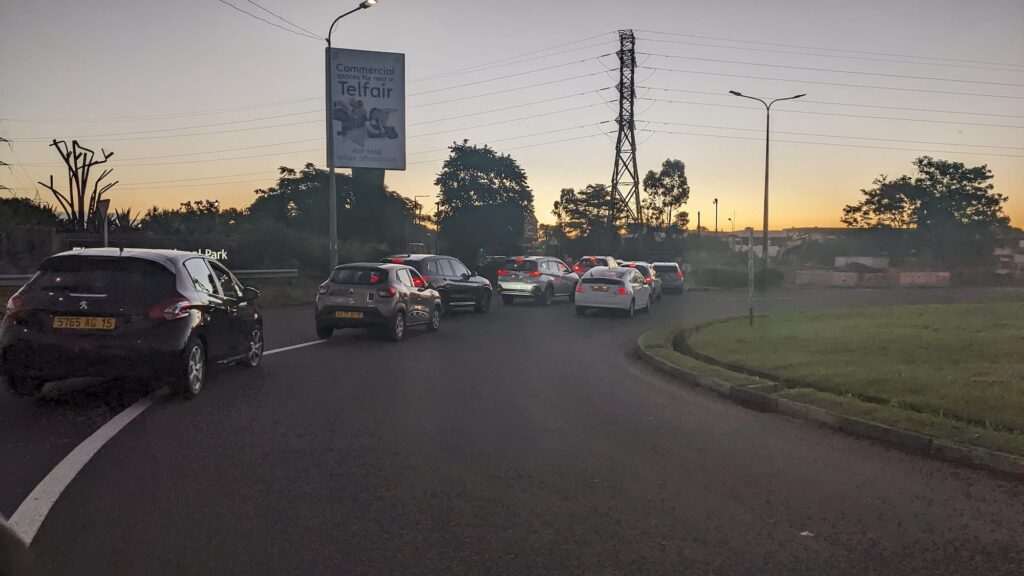
See our longer article: Driving in Mauritius
First things first — public transport is not good in Mauritius. It’s crowded, slow, and really not very romantic.
People do use public transport in Mauritius for going to the same place many times, e.g. work or a regular appointment. For that it’s fine and used by a wide range of people.
But I’d never suggest an outsider use buses in Mauritius for impromptu travelling. If you have a lot more patience than I do, then go ahead! (I guess I’m out of that phase of my life… it gets old after a couple of decades.)
But really, I have been in few places where I’ve needed a car for transport more than in Mauritius. In Central America I could get by walking a lot, or getting Uber or a street taxi sometimes. In Asia I rented a scooter, used scooter taxis, etc. In Africa, I used a bicycle, Uber, and roadside boda boda scooter taxis.
Mauritius has none of that. There’s no Uber, nor anything like it (no Didi, etc.). There’s no scooter taxis, no affordable taxi service (it’s like extra-high tourist prices only), and almost nowhere I’d recommend using a bicycle other than the highly touristy areas. (I see bicycles on the road and fear for their lives.)
So you need a car (or a scooter). You’d need a vehicle to
- Get to the interesting hikes or fun things to do
- Do any meaningful errands or shopping (our nearest supermarket — in a busy part of town — is 8 minutes drive away, and it’d be a nightmarish walk along major roads)
- Be able to go places when it’s raining, which is quite often and in random places (it might be sunny where you are, but raining 5 minutes away).
You should at minimum get a scooter — but these carry with them significant risks. I’m a huge motorcycle nerd and have ridden them in many countries, from 200 cc dirt bikes through to the 1340 cc superbike I have in my home garage. So suffice it to say I love them.
But when I saw the way people drive in Mauritius, I decided to stop riding a motorcycle. It’s basically 10% totally bonkers making life hell for the 90% of sane people.
That 10% bonkers part of driving in Mauritius is made up of
- A vast range of speeds — from 30% of the speed limit to 150% of it — at all times of day
- Unpredictable traffic, sometimes backed up for 20 minutes longer than Google maps predicts. It once took us 25 minutes to get out of the suburban street our house is on — a 2 minute journey on foot!
- Google maps being unreliable (it’ll frequently send you down one-way streets or tell you to turn where there’s no road, etc.)
- Drivers with no lights on, high beams permanently on, or crazy lights on (e.g. the headlights set to permanently flash)
- Trucks tailgating you to intimidate you into letting them pass
- People cutting in lines of traffic
- Road works along very major routes
- Randomly closed roads, sometimes at different times of day
- Old buses driving very slowly and spewing out diesel fumes into your face
- Scooters with no lights on in the dark at night time
- Traffic lights constantly out (sometimes on purpose as police do a better job of it)
I’m over the craziness, mostly because I’m tired of driving one hour to go places I go to regularly that should only take 15 minutes to get to, but also because I got into an annoying accident.
In our last few days, a car decided to pass me while I was turning right (they ignored my turn signal it seems), and I they hit me. If I was on a motorcycle, I’d be badly injured. As would have they. As it stands, it’s still hugely annoying and inconvenient, as they are doing the predictable thing and evading responsibility by lying and making stuff up (e.g. claiming I was inebriated — bold claim for someone totally sober). I didn’t have to pay anything, but it was a waste of a day and stress energy.
Basically:
- Plan on driving a car.
- Assume that drivers are the worst
- Assume traffic is the worst
- Try not to get into an accident, but it’s not entirely up to you.
There. That might just put you off from visiting Mauritius… but it’s the truth!
Languages of Mauritius
See our longer article: Languages of Mauritius
In Mauritius, by far the most widely spoken language is Mauritian Creole, a French-based Creole that will be essentially impossible for you to understand in long phrases unless you know it already — though a French speaker can understand short phrases.
Mauritian Creole is very different from French. Here are a few phrases I picked up that highlight the differences:
| French | Mauritian Creole |
|---|---|
| Comment ça va? | Ki manyer? |
| Je ne comprends pas | Mo pa konpran |
| Je ne peux pas maintenant | Mo pa kapav asterla |
| Je veux de l’eau. | Mo anvi delo. |
| Je voudrais de l’eau | Mo kapav gagne delo? |
| Où sont les toilettes ? | Kot ena toilet? |
Some of those phrases bear some resemblance to the French, but bear in mind that you have the time and patience to look at a short phrase and understand it. When Mauritian Creole is spoken at length, it gets much harder.
Anyway, if you’re travelling short-term, nobody will expect you to understand Creole. The most important thing is to know that people may not be able to converse with you in English.
If you speak French, use French. I found many people who don’t speak English but who do speak French, even though they’re not totally comfortable in it. Even if your French isn’t perfect, it’s likely a better language to use than English.
And if you speak French, you may learn to pick up some Creole after a few months as I did.
In group situations, people will speak Creole to each other. It sounds weird to interject in English. But because French has so much in common with Creole, it doesn’t sound as weird to interject in French.
Of course, you can use English with many people around Mauritius, just not everyone. In service situations, most servers and staff will speak English, just not as fluently as French (or Mauritian Creole).
One final oddity to mention is that because English gets higher priority in education, people can often read and write English better than they can French. So quite often I text people in English but speak to them in French. Fun!
Food in Mauritius
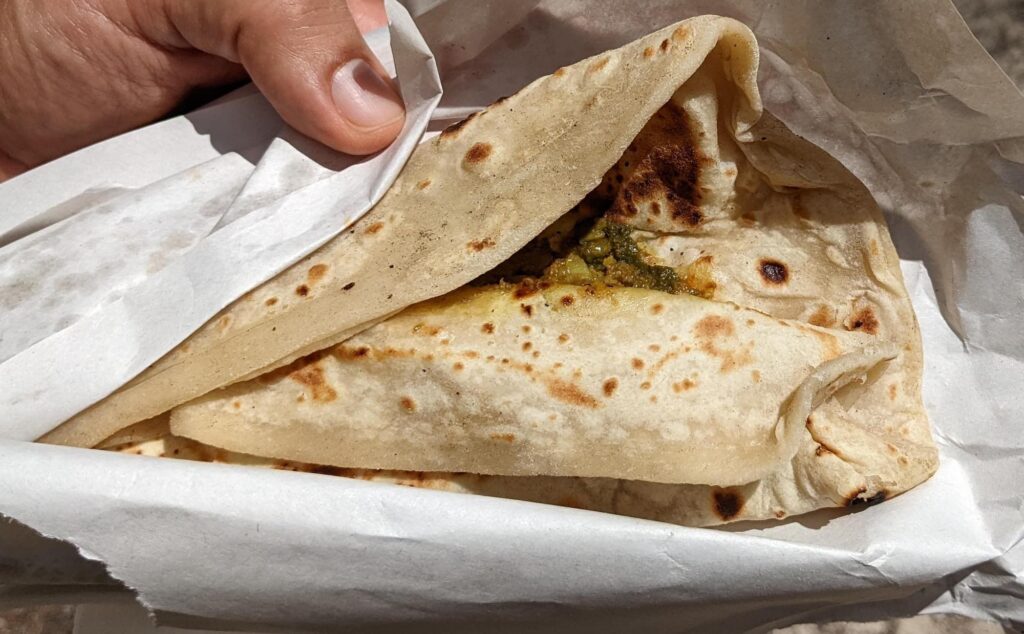
Food in Mauritius is interesting, but despite its cultural significance and special place it holds in the heart of Mauritians, it’s not food that would draw the international food traveller in search of the world’s greatest delicacies.
However, it’s interesting to see the impact that Hindu, Muslim, and Chinese cultures have had on staple foods. So I’d suggest trying a few things for the cultural experience.
Here are a few of the foods in Mauritius that I think are worth trying:
- Dholl puri: Chickpea soft flatbreads with some bean and tomato sauces in it. Wholesome and nourishing, and a common staple food, if unexciting, so don’t expect it to be a flavour explosion and you may like it. I like it in the same way I like eggs and avocado on toast — warm and nourishing.
- Roti: By far the tastiest thing we had. A roti with curry in it is an awesome thing to eat at the beach. In fact, get two.
- Briyani: Rice with vegetables and beef folded through it. Known to be a Muslim meal and it’s best around Port Louis.
- Alouda: A sweet vanilla milk drink with ice cream melted into it. Can’t really go wrong…
- Haleem: A lamb and lentil soup that’s a staple food and sold at lots of street corner shops.
Here are some other foods you can get in Mauritius but which I think are more missable:
- Bol renversé: Literally “upside-down bowl”, it’s a bowl of rice with stuff in it (e.g. some bits of vegetables, sausage) served in an upside-down heap.
- Mine bouillie: Boiled noodles with a bit of meat and vegetables (and MSG). Salty and savoury. Similar to mines frites (fried noodles).
- Boulettes: Basically a Mauritian take on dumplings. Often served in soup.
- Vindaye: A curry loosely related to vindaloo but which tastes different.
There are a few other dishes of interest too… basically, following our “hot and noisy” principle, we just found vendors where there was a line of people queuing up and ordered what everyone else was getting!
What to do in Mauritius
See our longer article — the Mauritius Bucket List Map
In terms of “what to do” in Mauritius, I’d really say it’s about two things: hiking and water sports/activities.
Mauritius is home to lots of really fun hikes. They’re generally difficult hikes up the side of a mountain with spectacular payoffs. Most can be done in a day-long return trip.
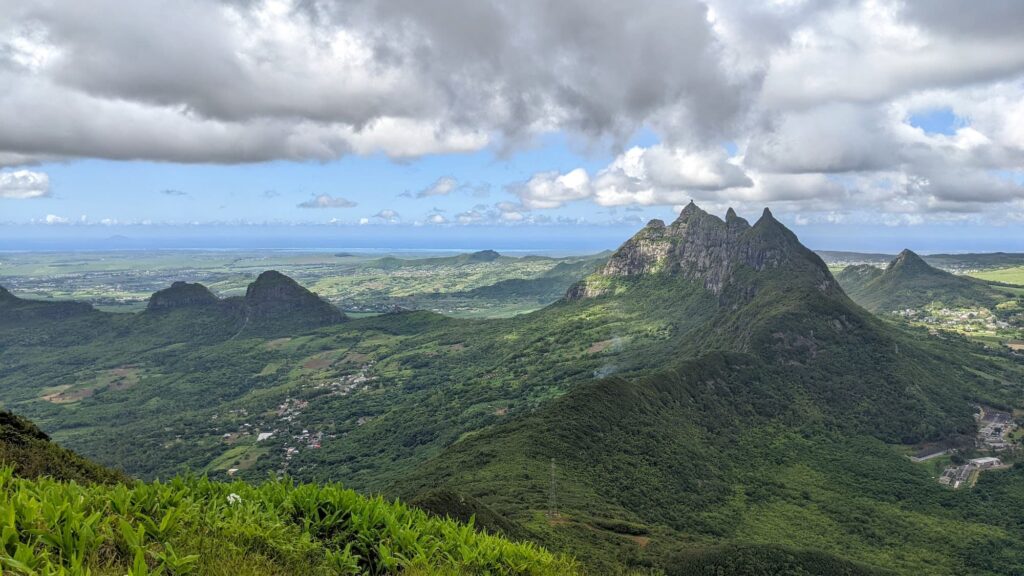
A few of the hikes are dangerous and you should get a guide, too. The danger comes in a few forms: getting lost, difficult passes, not knowing how to deal with dangerous river passes, or encountering a hidden drug cache and armed guard and not understanding what to do (I’ve heard from friends, anyway).
There are also extremely beautiful waterways around Mauritius. There’s lots of kite surfing, windsurfing, general boating, diving/snorkelling, and also regular surfing beyond the break (I’ve heard).
We did a bit of both those things. I also spent quite a bit of time studying Brazilian Jiu-Jitsu in Mauritius with the local black belt, because that’s the kind of thing I do!
Safety in Mauritius
Yes, Mauritius is pretty safe — in the daytime. Practise general street smart rules and you’ll be fine.
At night time, don’t go walking outside alone in urban areas. Actually, at night time, I would avoid walking outside altogether.
It’s not that it’s dangerous like downtown LA. Nobody is going to shoot you. But there are lots of times I’ve driven down a street at night time and things have gotten very seedy very fast, e.g. accidentally finding a shady red light district (prostitution is illegal in Mauritius and associated with other crime) down a road I just thought was another suburban road.
If you’re in the rural areas, you might be able to walk around at night time more. But you’d have different problems, like drivers who may not see you, or being accosted by strangers and nobody being around to help.
Internet and Getting a Sim card in Mauritius
The good news is that data rates in Mauritius are good!
We generally got fast connections over our ADSL in our apartment — downloading at a few MB per second. It’s probably not fast enough for the highest speed stuff (e.g. if you’re a gamer), but we never suffered.
Most of our work is web stuff, living in WordPress, and doing photo editing and some video. So we don’t need high-bandwidth connections for moving massive amounts of video data, for example.
Getting a sim card is quite useful, though, particularly if you want to do some remote work. There’s always the risk the internet may be down or slow, too — for example, when our host was changing internet provider.
To get a sim card, find a My Telecom store. Take your passport. You have to get a pre-paid sim card first (which costs a trivial amount) and then buy a tiny recharge. Everyone there will help you do it.
Then once at home, open up the booklet and use the guidance to a) buy more credit for your phone, and b) once you have the credit, use it to buy the data pack you want.
So first we recharged. Knowing I wanted a big data pack, I think we recharged for 1000 MRU each (about US$24).
We then bought a 3-month data pack for 815 MRU of that credit that gave us a whopping 270 GB of high-speed data that we didn’t come close to using up, despite streaming lots of TV shows at the gym.
See here for the other packages you can buy.
Generally we found we could connect to 4G / LTE in many places. Sometimes it’d drop down to H+, but even that was fast enough for browsing and most things.
Money and Exchanging Money in Mauritius
The best news is that international credit cards work in Mauritius. If you have a card with tap-and-pay, you should be able to use it in lots of places — basically every restaurant, supermarket, or shop.
If you haven an iPhone, I found that tap-and-pay works with that, too.
But if you have an Android phone, bad news — Google Pay isn’t active in Mauritius yet as of mid 2022.
(Check here for the updated list of Google Pay geographies.)
Because Google Pay isn’t available, and because Android is by far the most common system in Mauritius, many people will tell you tap and pay won’t work on your phone, even if you have an iPhone. (But we always found iPhone tap and pay worked, to the surprise of a few people.)
If you don’t have tap and pay, credit cards will work as you expect. If you have an old tech credit card from the US that needs signature verification, that works too, and usually people don’t ask for the signature as they won’t have a pen.
You need cash in Mauritius for a lot of stuff, though — street or food stall food, local businesses like tour guides, low-cost expenses like an alouda drink at the market, or just those situations where the person says their machine is broken.
Luckily, exchanging money is mercifully simple in Mauritius. No black markets, no shady people on the side of the road, like in some countries. This is one thing I have been VERY grateful for!
You can either exchange cash in banks or just use an ATM card. You’ll get the same rate. (Of course you’ll pay ATM fees on top if you use a card.)
Banks are usually in little clusters e.g. in a downtown suburban area, and there’s actually a fair degree of variance in rates between them, amounting to maybe a percentage point, so check out a few in person to see the latest rate. That extra $2-3 could buy you a delicious roti!
Sum up — Should you try living in Mauritius?
If you can work remotely and can set yourself up in a place where you don’t have to drive much (or at all), living in Mauritius can be a great way to enjoy a relaxed lifestyle ad a lot less cost than living in a western country.
The only significant downsides to the Mauritius lifestyle are the driving and traffic.
But if you can avoid those — Mauritius would make a great destination for many a digital nomad.


